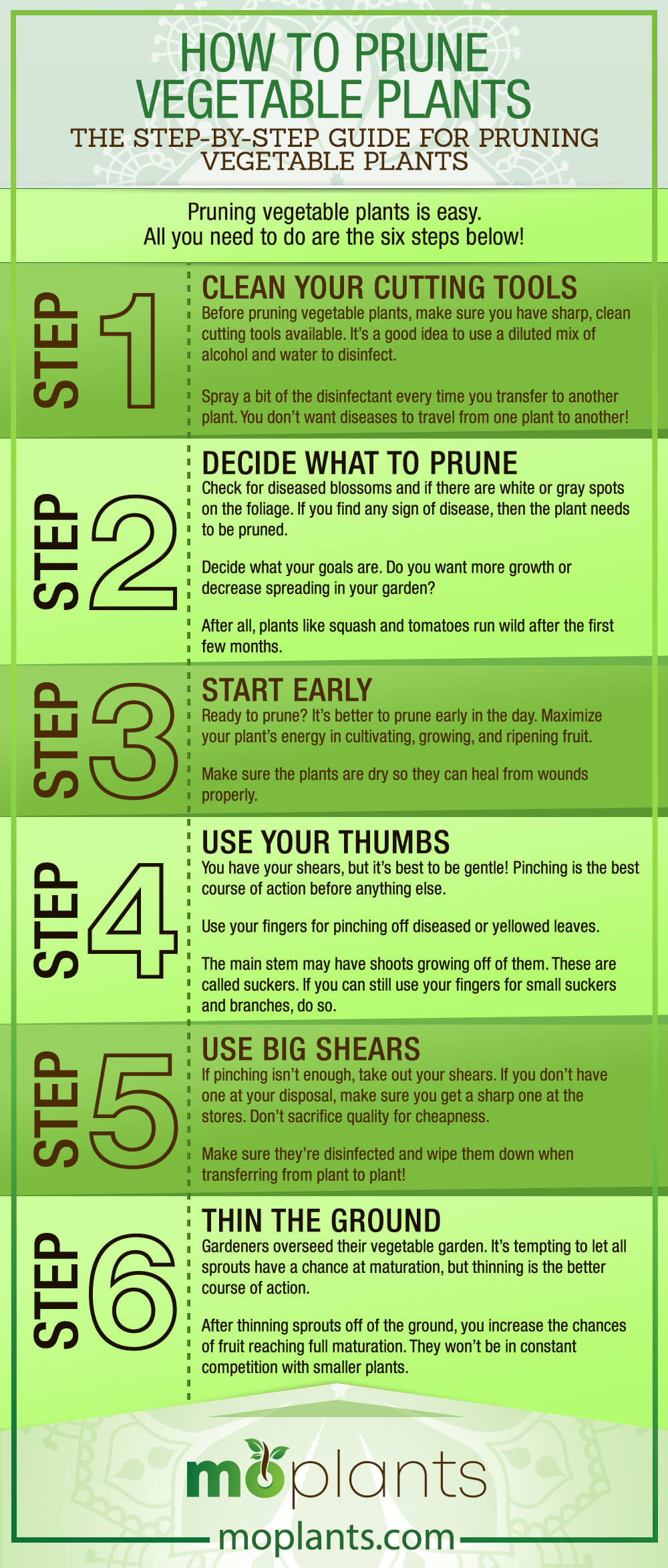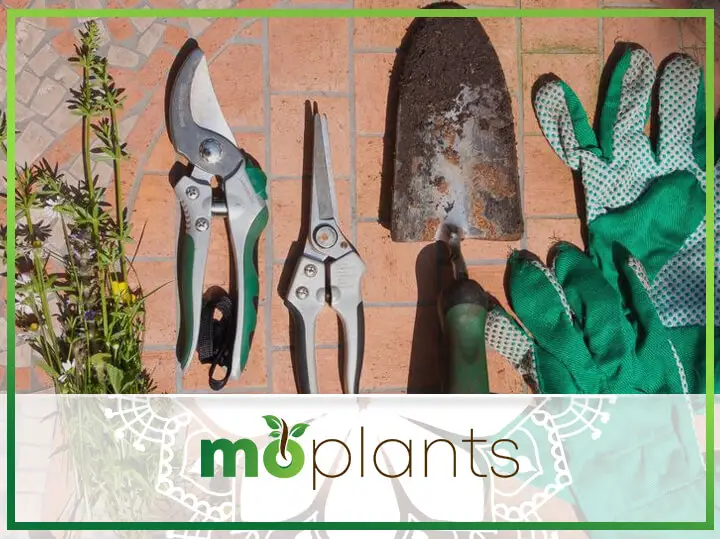Gardening can be a difficult task despite looking so simple. If you’re debating how to prune your plants, you can worry no more. In this article, you access a guide, benefits, and tips!
What You’ll Need
- Cutting tools
- Disinfectant
The Step-by-Step Guide for Pruning Vegetable Plants
Pruning vegetable plants is easy. All you need to do are the six steps below!
Step 1: Clean Your Cutting Tools
Before pruning vegetable plants, make sure you have sharp, clean cutting tools available. It’s a good idea to use a diluted mix of alcohol and water to disinfect.
Spray a bit of the disinfectant every time you transfer to another plant. You don’t want diseases to travel from one plant to another!
Step 2: Decide What To Prune
Check for diseased blossoms and if there are white or gray spots on the foliage.
If you find any sign of disease, then the plant needs to be pruned.
Decide what your goals are. Do you want more growth or decrease spreading in your garden?
After all, plants like squash and tomatoes run wild after the first few months.
Whatever it is, start at the bottom. This allows more light and air for the ground.
You can go up to overcrowded leaves. Don’t cut off too much – foliage serves as protection from sun scalding.
Avoid cutting large branches – those branches are a part of a plant’s nutrition. Don’t prune more than twenty-five percent of the plant, either.
Step 3: Start Early
Ready to prune? It’s better to prune early in the day. Maximize your plant’s energy in cultivating, growing, and ripening fruit.
Make sure the plants are dry so they can heal from wounds properly.
You can prune year-round, but it’s commonly accepted to do so during the early spring season – just before the onset of new growth and harvest.
Step 4: Use Your Thumbs
You have your shears, but it’s best to be gentle! Pinching is the best course of action before anything else.
Use your fingers for pinching off diseased or yellowed leaves.
The main stem may have shoots growing off of them. These are called suckers. If you can still use your fingers for small suckers and branches, do so.
Step 5: Use Big Shears
If pinching isn’t enough, take out your shears.
If you don’t have one at your disposal, make sure you get a sharp one at the stores. Don’t sacrifice quality for cheapness.
Make sure they’re disinfected and wipe them down when transferring from plant to plant!
Step 6: Thin the Ground
Gardeners overseed their vegetable garden. It’s tempting to let all sprouts have a chance at maturation, but thinning is the better course of action.
After thinning sprouts off of the ground, you increase the chances of fruit reaching full maturation. They won’t be in constant competition with smaller plants.
Infographic

Why Prune Vegetable Plants?
A fair warning: most pruners are still undecided on whether you should prune your vegetable plants. Some studies say pruning discourages growth, but gardeners have found varying outcomes.
Home gardening has different results. Pruning has a ton of benefits for you! Let’s get into them below.
Allows Room for Growth
When overgrown foliage covers the ground and the plant itself, these plants can’t access nutrients.
Light and air can’t enter. Even rainwater won’t be able to reach the plant’s roots. All three is considered plant food, and you’re denying your plants those!
When gardening, you want your plants to have the best yields and fruit production. For this to be possible, they should be able to synthesize sunlight and receive water. Pruning allows that to take place!
Plus, you remove dead branches and stems from the gardening site. You clear your garden, allowing more air circulation around a compact area.
Leaves Plants Healthy
Removing dead branches, diseased leaves, and decaying blooms keep your plants in good shape.
Regular pruning clears the ground, eliminating all habitats for pests.
These pests can hide under overgrown foliage with no sign! You’re left to wonder what on earth is eating the sprouts and spreading disease.
Besides, these pests can also become uninvited house guests for any gardener. You’re protecting yourself, too.
Encourages Crop Yield
One of the benefits of pruning is growth stimulation.
You don’t just clear the area for new growth – you also harvest more!
Instead of putting most of their energy into growing suckers and foliage, they can focus on putting their energy towards their fruit.
In the end, you benefit from the quality and fruit size of your harvest.
What Plants Should I Prune?
Let’s discuss pruning vegetable plants, what you should prune, and general tips! Treat this part as an extension of the pruning guide above.
A Pruning Guide: Peppers, Cucumbers, Squash, and Tomato Plants
Pruning a tomato plant depends on what type of tomatoes you have in your garden. Tomatoes usually come in two varieties.
If you have determinate bushy tomatoes, it’s best not to cut off many branches. Pinch off yellowed leaves instead. If the plant shows signs of disease, pinch those off, too.
If you have indeterminate tomatoes or vining plants, pruning may be necessary. Gardeners usually train vining plants to grow on trellises, then prune tomato suckers as they grow. Pinching is good enough!
Cut off a couple of the main stems.
Others grow tomatoes in cages. If your tomatoes are overgrowing their cage, prune the tops of the new growth.
Pruning can help your tomato harvest in terms of production quantity and health!
Cucumbers
When gardening, pruners don’t pay that much attention to cucumbers.
These plants don’t require pruning, but it’s necessary if you have compact lots and cages. Plus, you may notice mildew or fungi on their flowers and leaves.
Pruning your cucumber plant is easy. Search for fungi, then trim diseased parts and pinch off growth points. If your cucumber plant is outgrowing its cage, prune the tops of the plant.
Squash
Squash plants tend to spread, so it makes sense to trim them when necessary. Others may suffer from diseases. Fungi plays a part, too.
Identify the end of the vine that you need to cut. It usually sits behind two leaf nodes after the last fruit. Cut this off with your shears.
If possible, prune male flowers and leave female flowers behind. Male flowers don’t produce squash at all. They have long, narrow stems with a stamen.
In comparison, female flowers produce squash. Check to see if there’s fruit at the base of the flowers. Leave these on your plant when pruning.
If you’re growing your squash vegetables on a trellis or stake, let it grow! You can prune all the leaves on its stem from the fruit to the ground.
Peppers
Wait after germination before pruning pepper plants! Locate the third set of leaves and cut the main stem with your shears. Pinch off suckers, shoots, and flowers as you like.
We encourage one thing: pruning the main stem and pinching off new suckers if needed. Garden yields can be sturdier and increase in number!
In Conclusion
Pruning vegetable plants isn’t a necessity, but it still has a lot of benefits.
If you can, consult a horticulturist. It’s best to get an experts’ opinion before pruning!
They’re the only ones who can know for sure what your plant needs. Plus, they can make more suggestions for the betterment of your garden lot.
We hope you enjoyed this guide’s content! Tell us your thoughts below.


